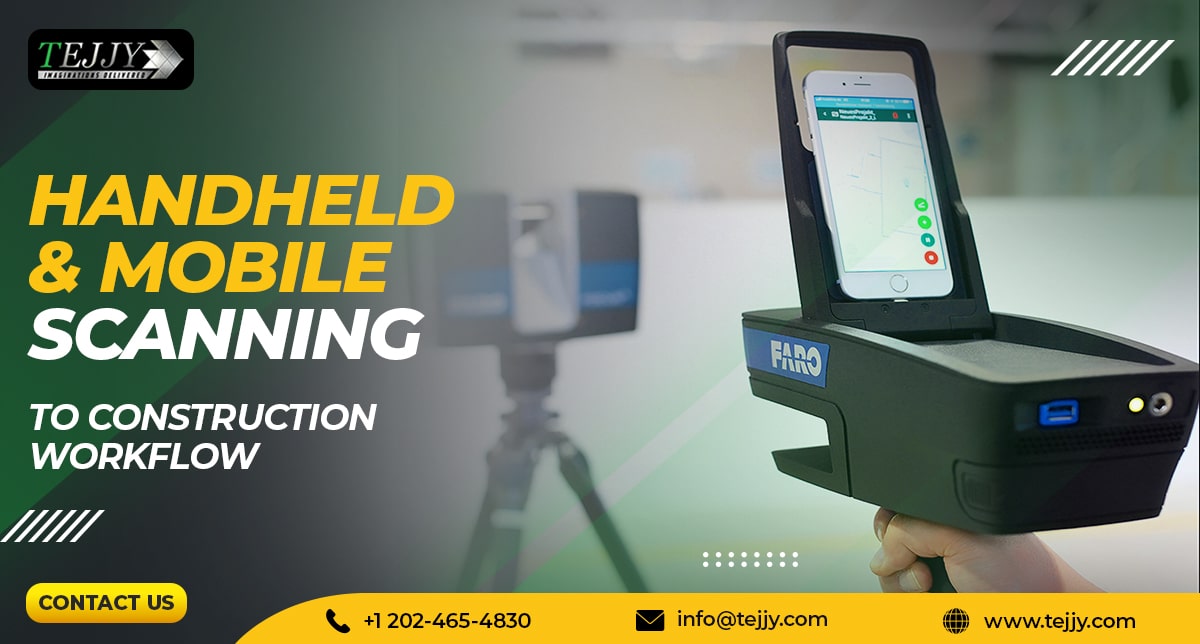Today, the construction companies are implementing innovative technologies like BIM, Laser Scanning, Prefabrication & Modularization, Virtual Reality, Augmented Reality, and 3D Printing. 3D laser scanning is chosen to be one of the best ROI strategies in building design and construction technology in 2020. About 51% of the AEC professionals use 3D laser scanning on their projects and about 2/3rd use laser scanners on projects.But the question is whether the construction sector is using the right scanning technology for getting the ROI?
Handheld scanners are created for usability, movability, and speed, using Simultaneous Location & Mapping (SLAM) lidar for scanning while walking around a job site. The handheld scanning technology can enhance the ROI of 3D scanning to a greater extent.
Contents
- 1 Now, why should you add handheld & mobile scanning to construction workflow? Let’s take a look at the reasons in this regard:
- 1.1 1. Scanning Faster While Walking
- 1.2 2. Getting Additional Information in Less Time
- 1.3 3. Seizing Photographs & Point Clouds Together
- 1.4 4. Getting Smaller & Complicated Spaces
- 1.5 5. Conducting Survey Without any Requirement of FAA Authorization
- 1.6 6. Facilitating Working Around with People
- 1.7 7. Performing with Speed with Negligible Training
Now, why should you add handheld & mobile scanning to construction workflow? Let’s take a look at the reasons in this regard:
1. Scanning Faster While Walking
Conventional tripod-based scanners demand a stop-and-start workflow encompassing alternating periods of setup, scanning, and transport to the subsequent position of scanning. This approach is a bit tedious and time-consuming.In contrast, handheld SLAM scanners facilitate workers to scan constantly while walking. Walking while scanning is a time-saver, less tedious, and more comfortable scanning task, making it roughly what the employees want to perform.
2. Getting Additional Information in Less Time
Handheld lidar scanning helps in getting more information for the digital transformation. The workflow with the handheld lidar was faster compared to the traditional terrestrial scanners but used by fewer employees. Scanning can be completed in just 4 field hours with the handheld lidar scanner and the cost is also less compared to the conventional tripod-based scanners.
3. Seizing Photographs & Point Clouds Together
Many of the handheld lidar scanners are integrated with a camera for simultaneously capturing color images while scanning. This saves the stride of distinctly capturing images with an external camera, and does not require extra time for capturing.The outcome of a scam is a colorized point cloud – an amalgamation of the lidar points and the color image. The imageries are also presented to view and assist in detecting and modeling elements from the capture, or simply as a quick technique to look back at a particular site.
4. Getting Smaller & Complicated Spaces
It is likely that on the construction site, the job site will be open with complicated spaces that need to be captured. The contractors may find that they are accessing complex structures or other geometry that would prevent the usage of conventional scanning gears. Instead of skipping those complex and minute spaces, handheld scanning permits a complete capture of a job site. Using a handheld scanner, the footprint is smaller, allowing it to fit where others cannot. Obstacles can be avoided with a handheld scanner at a close-up scale instead of across a room, leading to a complete scan with fewer tedious repositioning. The long pole of the handheld scanners can also be used for looking into places where an ordinary person might not be able to squeeze through.
5. Conducting Survey Without any Requirement of FAA Authorization
Drones in the construction site could be great for outdoor overviews, though it can be difficult to effectively and safely deploy them indoors. Considering with ever-changing drone guidelines, using drones in construction is often not a forthright endeavor. However, adding a handheld scanner to the tool set, helps to survey the places where drones cannot go without any approval from the FAA.
6. Facilitating Working Around with People
Construction Technologies job sites are active, with people moving from one part to another according to the tasks of the day. Waiting for a specific section to become empty for scanning or to scan after hours (with employees accruing overtime) often gets costly. Moreover,requesting a group of people for vacating an area can be troublesome, delaying the work progress. Handheld scanners facilitate in working around people and capturing good statistics. Even if people get still for a minute while walking through, the device helps to capture the complete scene.
7. Performing with Speed with Negligible Training
Performing a scan with a handheld scanner doesn’t need much training compared to a traditional scanner to operate. This helps to distribute the task of the scanning site to the available workers, instead of relegated to a single expert on-site.A simple workflow entails turning on the scanner, placing it into a holster, and walking around the job site. The tablet display helps to stop the scan once the route gets completed, and the scanner processes the data. Attached displays also provide feedback as the scan gets captured. As a result of which anyone using the scanner can capture professional scans.
Interested to know more about laser scanning Construction Technologies? Get in touch with the BIM Modelers of Tejjy Inc. in the USA at 202-465-4830 or [email protected] to enhance your existing construction workflow.
